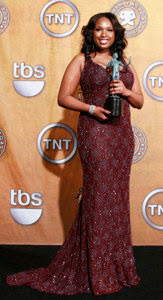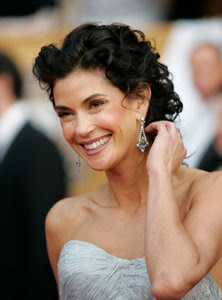Oscar Wrap-up
 This year's Academy Awards was the return of Old-Skool.
This year's Academy Awards was the return of Old-Skool.
It was the anti-American Idol. The public doesn't vote, the clubby Academy votes. Instead of trying to get any younger viewers, it went straight for the middle-aged core audience. And the big winner was the sixty-four year old Martin Scorsese. The only bright spot was American Idol cast-off Jennifer Hudson, who looked very out of place.
The Red Carpet, as usual was chaos. The big problem was that some of Hollywood's biggest stars didn't bother walking the Red Carpet because of the danger of bumping into an old flame. Ben Affleck didn't want to be seen in any photos with Jennifer Lopez. Tom Cruise wanted to avoid Penelope Cruz and Nicole Kidman. Publicists had to make sure that Jennifer Biel and Cameron Diaz, both who dated Justin Timberlake, didn't have a cat fight. Kidman walked the red carpet with a pregnant Naomi Watts, shedding their significant others.
This was supposedly a "green" awards show. I did not see any evidence of that. No carpeting made of recycled materials. The limos burnt gas. No solar powered Klieg ligts. If anything it only pushed the stereotype of Hollywood being an out-of-touch radical left-wing crazed cabal.
You had the openly gay Ellen DeGeneres hosting the show. The "married" Melissa Etheridge winning the best song. Vice-President Al Gore got the loudest applause when an "Inconvenient Truth" won best documentary. Prius driving Leonardo DiCarprio, Cameron Diaz and Larry David were in full force, not to mention the king of conservation, Ed Begley Jr. You come to an Awards Show and the Democratic National Convention broke out. Hey, I'm a liberal who grew up in New York, but do we really have to wear our politics on our tuxs? Let's save it for the Global Green Awards party.
Hey, I'm a liberal who grew up in New York, but do we really have to wear our politics on our tuxs? Let's save it for the Global Green Awards party.
It's always fun when to watch what Hollywood actors, most of whom live inside a bubble of yes people, think of what to wear to basically the ultimate fashion show, the Oscars. I think some people come to the Oscars just so they can get their photograph into a magazine's worst dressed list. Sally Kirkland wears the most hideous things every year. Jennifer Hudson got Vogue magazine editor-at-large Leon Talley to pick out a dress. Big mistake on the weird Star Trek inspired shrug. Meryl Streep and Faye Dunaway have let their subscriptions to fashion magazines lapse. I'm no fashion expert, using instead as my rule of thumb "the what were they thinking" acid test.
For any photographer covering the Oscars, it truly a day that never ends.
I got up at around 9:00 a.m. at the Roosevelt Hotel. I went through an equipment check, made a few phone calls to my editors, and then walked down to the Kodak Theater to check the strobes in the press room. From 11:00 a.m. to 2 p.m. the press room is closed for a security sweep, so if you want to check your lights you have to be there at around 10:30 a.m. After the lighting check I went to meet my runners who would be walking my digital cards from my spot on the red carpet to the hotel room where an editor was stationed.
I gave them a tour of the complex and told them the ground rules. Runners can't take photos, can't loiter and watch, and had to stay within a marked path. They do have a pass that give them access to all the regular media areas, which is great. Around noon I walked a couple of blocks to get a quick lunch at a local fast food joint and then back to the Red Carpet where I tried to make a few feature photos before the big event. That lasts until about 2 p.m. From 2 until 5:30 the stars walk the red carpet. The last hour is non-stop shooting. I burnt up one flash, which I quickly replaced with a back-up, and went through a couple of Turbo batteries. After about 2,000 shots and 10 digital cards with a half-dozen trips by a messenger to an editor, the Red Carpet was done.
Around noon I walked a couple of blocks to get a quick lunch at a local fast food joint and then back to the Red Carpet where I tried to make a few feature photos before the big event. That lasts until about 2 p.m. From 2 until 5:30 the stars walk the red carpet. The last hour is non-stop shooting. I burnt up one flash, which I quickly replaced with a back-up, and went through a couple of Turbo batteries. After about 2,000 shots and 10 digital cards with a half-dozen trips by a messenger to an editor, the Red Carpet was done.
Part 2 was the Awards Room, where the winners and some presenters go back and get their photo taken. They changed things this year and only announced the big winners in the last hour of the show. That meant waiting around and shooting meaningless photos of obscure categories winners for 3 hours until someone the magazines cared about showed up.
Around 10 p.m. I started packing up all my equipment and headed back to the hotel for some editing. My editor pumped out around 300 photos while I was shooting. I then spent the next nine hours pushing out another 500 or so photos. I was up for 23 hours, slept for 3 hours and then drove home. Until next September, Awards Season is officially over.














